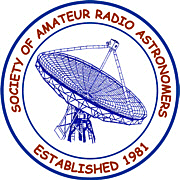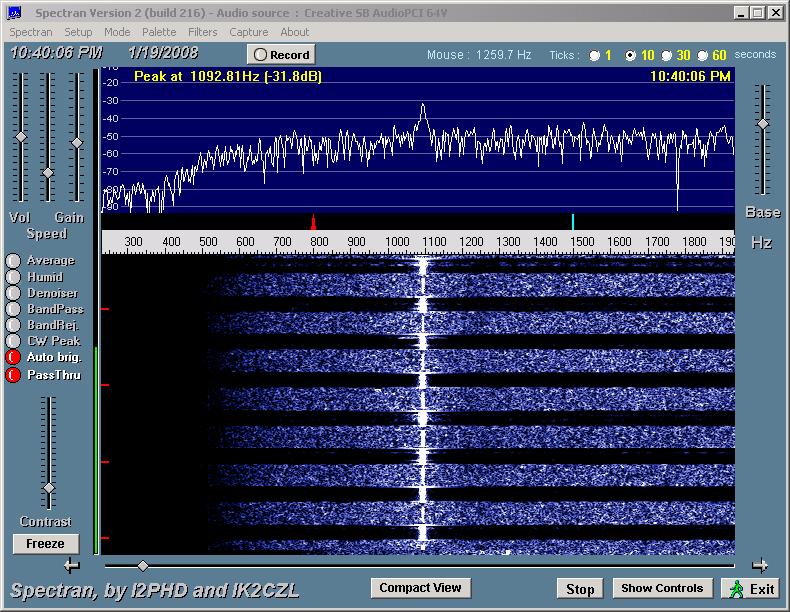

Above you see the logos of two organizations that I belong to. This webpage is devoted to my interests and activities in radio astronomy and SETI (the search for extraterrestrial intelligence). If you are interested to know more about either of these subjects I suggest to take these links to discover what this is about. I am a former board member of the Society of Amateur Radio Astronomers (SARA) and am the Alaska volunteer coordinator for the SETI-League. If you are a resident of Alaska and would like to participate in either organization I would be happy to provide any information that I have. Please e-mail comments to:
 Of course you may contact them directly concerning membership or details on these subjects.
Of course you may contact them directly concerning membership or details on these subjects.
For information about radio astronomy look at NRAO's website. How Radio Telescopes work History of Radio Astronomy FAQ
As I briefly mentioned in my remarks about getting interested in amateur radio, I became interested in radio astronomy in college and persuaded the Dean of the Astronomy Dept. to allow me to do a research paper (reading class) about radio astronomy with the intent to set up a small radio telescope on 432-MHz. The radio telescope did not materialize, but I did produce a 70+ page paper which resulted in my being invited to do graduate studies at Ohio State University with Dr. John Kraus. Although I was excited about the prospect, I did not have the funds to attend at that time. Another problem was that graduate student draft deferments had been suspended in the height of the war in Viet Nam. I reluctantly decided to forgo my interests in radio astronomy and took an engineering position with Hughes Aircraft in Los Angeles in December 1968. A few years later in 1974, while working at Goldstone, I took a weeks vacation to New Mexico and visited the brand-new site of the Very Large Array (VLA) being constructed by the NRAO. I even inquired into working for them but discovered that they were not yet seeking employees. My freind Gordon, WA6FMX, who accompanied me on the trip and I got a unorthodox tour of the facility by one of the engineers. That was special since they were not setup for tours at that point. Many years passed until I could get back to thinking about radio astronomy, this time as an amateur scientist. I discovered SARA about 1997 and decided to join. I got involved in a project dealing with making radio transmission tests of artificial FAI (field-aligned Irregularities) with the HAARP facitlity in Gulkana, Alaska in 1998 and offered to present a paper at the annual conference that SARA holds at the NRAO in Greenbank, WV each summer. That began my involvement with the Society and encouraged me to think about building my own radio telescope. I happened upon obtaining a surplus microwave satellite terminal (with a 2.4 meter dish) at the same time. I retired the 2.4m dish in 2006 when we moved into our current home. I also purchased a surplus C-band TVRO dish of 4.9 meter diameter which will be my primary radio telescope at 1420-MHz. It will also be used at 1296-MHz for EME. In 1997 I attended the AMSAT Symposium in Tucson, AZ and met Paul Shuch (Phd) who was attending and hosting a table to demonstrate his newly designed 1420-MHz radio astronomy receiver-convertor. I discovered he was the Exec. Director of the SETI-League. They had been established only a couple years before. We got into a discussion about radio astronomy, SETI, etc. and Paul wondered if I would consider becoming a coordinator for them in Alaska, so I joined the SETI-League that year and agreed to take that on. My radio telescope, is equipped with one of the convertors that Paul designed and is marketed by Downeast Microwave, Inc. (DEMI). I built a short helix feed, purchased an LNA from Radio Astronomy Supply (RAS) and that feeds my convertor which is connected to my FT-817 144-MHz ssb radio. Using a soundcard program I can engage in narrow-band observations in the pursuit of detecting ETI signals on the 1420-MHz frequency band.
- 2003-2006 the 2.4 meter dish was fix-pointed south at an elevation of 36-degrees (declination = +6.675) to perform Meridian-transit scanning of the sky, but considerable re-engineering is needed to get the azimuth-elevation system working.
- Fall 2005, I replaced the helix feed with a septum feed.
- Spring 2006, I developed a prototype wide-bandwidth (129-154 MHz) IF-detector-integrator for continuum observations of the sky.
- Late summer of 2006 we moved to a new home which results in moving all antennas. I decided to revive a project to put up a 4.9 meter dish for 1296-1420 MHz. This is planned for 2008.
- November 2006, Reserved a Demo pc board version of the new SDR-IQ and purchased a DEMI 144/28 converter.
- The SDR-IQ was received on Jan. 4, 2007; DEMI 144/28 converter kit was completed Feb. 23, 2007. Initial use using Spectravue and Winrad software observing eme signals shows that utilization of the full 190-KHz span at very narrow resolution bandwidths (RBW) requires high speed cpu's. A PC with speeds greater than 2-GHz is needed.
- Wideband continuum observations of celestial sources await the completion of the 4.9m dish now planned for summer, 2008. Solar scans at 144-MHz will be attempted using the eme array and Spectravue.
- A new 2.33 GHz DELL computer with 2-GB memory was purchased in January, 2008. This will permit full bandwidth scan with the SDR-IQ for both RA/SETI and EME.
- Nov. 25, 2008, 4.9 meter dish was installed on azimuth-elevation support. Installation of azimuth/elevation linear positioners, feed support, septum feed, LNA, and cabling remain before dish is operational.
- Oct. 2010, I have two LNA's for 1.2-1.4 GHz to be installed, shortly. 432-MHz two-element quad feed was added in April for the special eme event at Arecibo. I measured 8-dB of sun noise at that time.
- Oct. 2013, A new feedhorn was installed with Ta=20K which will improve the sensitivity of the radio telescope. Sun noise to cold sky ratio is 15.9 dB on 1296 MHz. The dish is fully functional. Progress can be followed on the 1296 EME page.
- Oct. 2020, Dish was removed due to support structure damage; re-build and re-install est. Summer/Fall, 2023
- Feb. 2023, Looking at RSP-DUO (1-KHz to 2-GHz) to replace using the 1420-144 and 144-28 downconverters into the SDR-IQ. this one unit can receive wide-bandwidth of 10-MHz on a single channel or 2-MHz for running two channels. Much more sensitive than the 190-KHz SDR-IQ. Two LNA may be connected to the dish feed receiving in parallel. Summer 2023? See new block diagram.
Mar's Reconnaissance Orbiter (MRO) Radio Test: NASA is planning an in-flight test of its UHF Radio Relay aboard the MRO spacecraft on Sept. 21-22, 2005. They have invited amateur radio operators to monitor their test transmissions. The MRO UHF Relay transmits a 10 watt signal on 437.1 MHz (+/- Doppler) via an omni-directional, zero-gain antenna. It transmits a right-hand circular polarized signal. The test signal will be CW with no modulation. Detection of the carrier of the weak signal from the spacecraft at a distance of 14 million km will possible by amateur observers with high-gain satellite or eme antennas systems, and low-noise receiving systems using DSP waterfall spectrum computer software such as FFTDSP or Spectran. I have produced an Excel spreadsheet to calculate expected signal level from MRO. Save the spreadsheet on your computer and you can open it to analyze the expected performance of your reception of MRO by changing system parameters such as receiver noise temp and antenna gain.
HAARP 40 meter Bistatic Lunar Radar: I monitored the tranmissions and lunar echos from HAARP on both Jan. 19 and Jan. 20. I did not have my station set up for making spectral displays on the first night but captured jpeg images every 60 seconds on the second night. The signal was received on 6.804 MHz from 0630-0700 utc and at 7.408.600 MHz from 0730-0830 utc. Spectran was used to make the spectral display and waterfall. The signal was received on a 40 meter half-wave dipole 30-feet above ground into a FT-847 with AGC-Fast, Preamp-On, DSP NR=11, mode=LSB. I increased the waterfall speed about half-way. I have placed 73 jpeg images on this website at http://www.kl7uw.com/img0001.jpg thru http://www.kl7uw.com/img0073.jpg. Each jpeg file is about 130 to 145 Kb in size. The screen capture feature saved images of both the direct sky-wave signal and the lunar echo. You can see that the direct signal averages -15 dB signal strength while the echo runs about -31 dB.
- img0001 21:44:46 AST (0644 utc) Direct Signal = -14.2 dB on 6.804 MHz
- img0023 22:40:06 AST (0740 utc) Lunar Echo = -31.8 dB on 7.408.600 MHz

 Please check back as more content is added to this page!
Please check back as more content is added to this page!
Return to Home Page